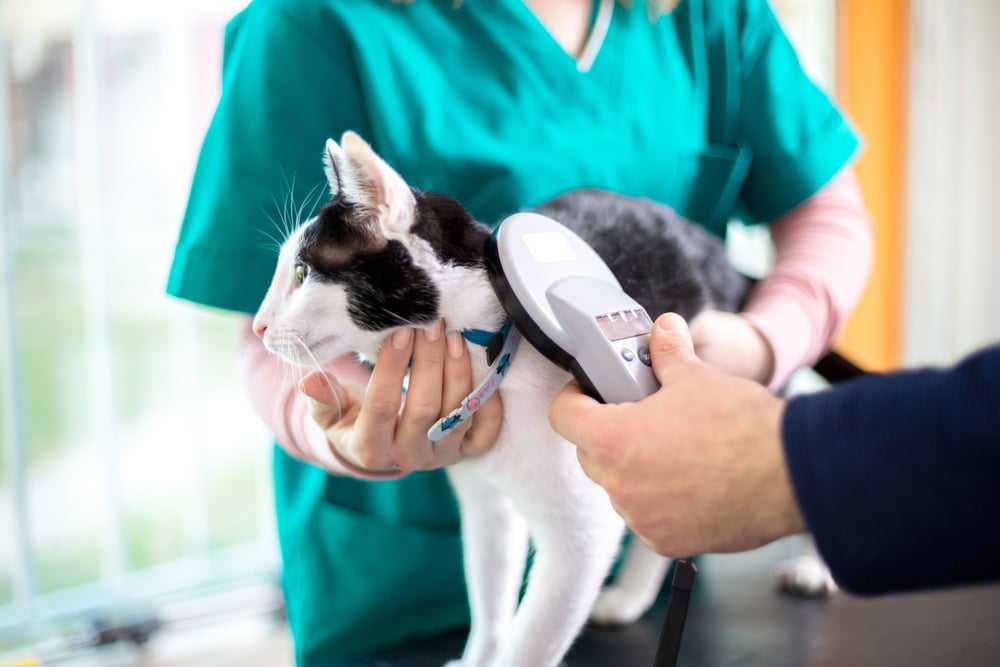The animal welfare organization American Humane estimates that 10 million pets become lost annually in the United States and that one in three pets become lost at some point during their lifetime. Moreover, the same organization estimates that only 2% of cats and 15% of missing dogs are reunited with their owners.
Luckily, those scary statistics look more favorable if your pet has a microchip. In a study of animal shelters, cats with a microchip had a 39% chance of being reunited with their owner and
52% of dogs with a microchip found their way home again. July Fourth is approaching, and during this holiday more pets go missing than on any other day of the year. Learn about pet microchipping from our Pets & Friends Animal Hospital team’s guide that explains what microchips are, how they work to protect pets, and how they help reunite families.
What is a microchip for pets, and how does the device work?
A microchip is a tiny device implanted under your pet’s skin with veterinary supervision. This capsule, about the size of a rice grain, stores a unique identification (ID) code that can be used to contact you if someone finds your lost pet.
Once the microchip is placed, register it by adding your contact information in the national pet recovery database. Your pet’s microchip can be scanned by any veterinary hospital, animal control officer, shelter, or individual with a universal scanner. When the scanner is passed painlessly over your pet’s body, the microchip emits a radio signal that the scanner recognizes, and your pet’s unique ID code is displayed on the scanner’s screen. The organization that has your pet can contact the database, which will contact you and help you reunite with your pet.
If you move or change your phone number, you must update your contact information with the database administrator. A microchip is only as good as the information registered in the database.
Benefits of microchipping pets

Having your pet microchipped is crucial to ensuring their safety and well-being. This tiny device gives you a sense of security and peace of mind, knowing that if your furry friend gets lost, you have a reliable way to reunite. Microchipping’s benefits offer protection against losing your pet amid circumstances such as during a fireworks display or a natural disaster. This simple yet effective device significantly reduces the risk of permanently being separated from your pet. Consider these pet microchipping benefits:
- Permanent — Microchips are a permanent form of identification for your pet that never expires. While collars and tags are essential, microchips can never be lost, removed, or stolen.
- Peace of mind — Microchips provide peace of mind. Even indoor pets can go missing. Your pet could scoot out an open door in a split second, and a microchip is your pet’s best chance of being reunited with you.
- Lifesaving — Microchips save lives. Some lost pets are injured and brought to emergency veterinary clinics for medical care. Veterinary team members breathe a sigh of relief when they hear the telltale beep that lets them know a lost and injured pet has a microchip. The microchip enables caregivers to immediately contact a pet’s owner and gain permission to provide urgent veterinary care.
- A quick, painless procedure — Microchips are easy and inexpensive to place. Contrary to what many pet owners may believe, placing a microchip is not painful for pets. The procedure in pets is similar to giving a vaccine. Of course, if your pet is anesthetized for a dental cleaning or other procedure, the microchip can be placed while your furry pal is under anesthesia.
Microchipping your pet is a reliable way to ensure the safety and well-being of your beloved companion. Microchipping is a simple and inexpensive procedure that every pet should have. Protect your pet and provide them with the security they deserve. Contact our Pets & Friends Animal Hospital team for more information about microchipping and to schedule your pet’s microchip placement appointment.

